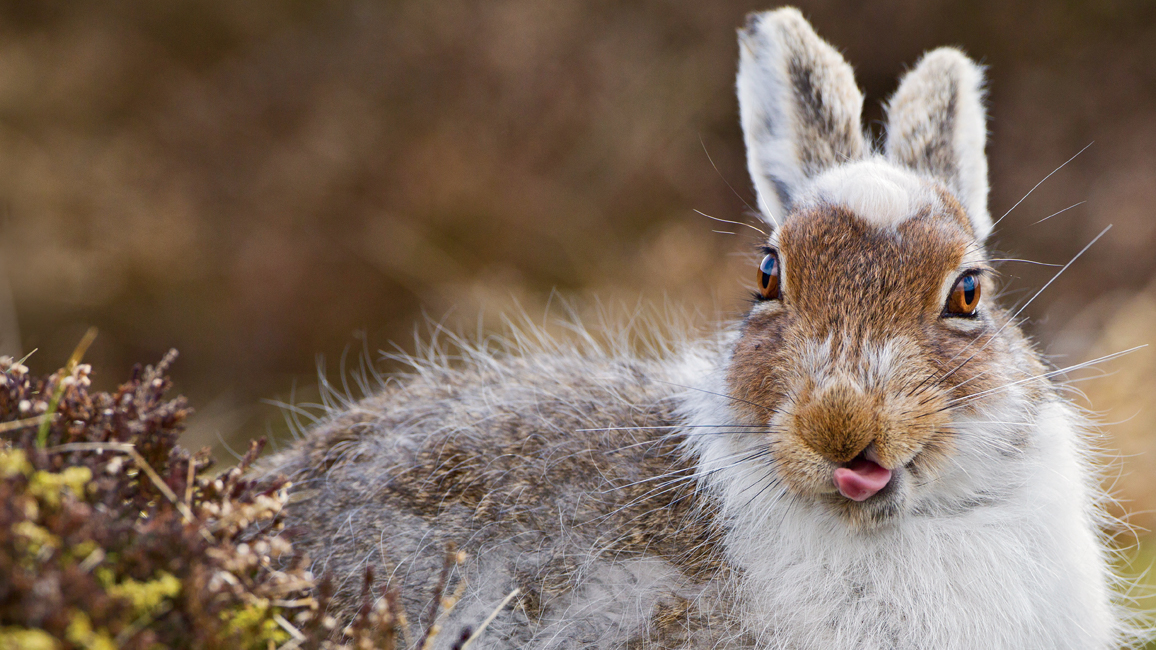
Mountain Hare
By Harriet Hare, as told to Hannah SchardtWhen you look at me, what do you see? A brown bunny? A white rabbit?
Actually, I’m a mountain hare. (Hares have longer legs and larger ears than our rabbit cousins.) Depending on the time of year, I may be smooth and brown or fluffy and white–or, as in the photo at right, a little bit of each! That’s because my coat changes with the seasons.
Mountain hares live in many places in Eurasia (see map). My home is in the Scottish Highlands. Follow my footprints into the mountains to find out why, for me, change isn’t just good–it’s an absolute must.
Wind-Blown Hare
The Scottish Highlands are one of the wettest, windiest places in Europe. And in the winter, my mountain home is downright freezing! Winds here blow up to 100 miles an hour. And the world around me turns white with snow. Good thing I have this toasty fur coat!
All year long, my coat has three parts: the short underfur, medium-length pile hair, and long guard hair. But overall, the fur of my white winter coat is longer and denser than the fur of my brown summer coat. So it keeps me warm, even on the coldest days. It also helps me hide. Hungry eagles are always out there, scanning the mountains for a meal. From a distance, I blend right in with the snow.
A fuzzy coat isn’t the only part of me that is built for blizzards. See my ears? They may look long to you, but they are pretty short for hare ears. With short ears, I lose less body heat to the air. And these large, furry feet? They spread my weight and keep me from sinking into deep, soft snow.
Time for a Change
In early spring, the snow around me starts to melt. That means it’s time for me to shed my winter whites. My shorter, brown summer coat starts to grow in. When the last patches of snow have melted, any white patches on me stick out like a neon sign for predators: EAT ME! So I try to lie low while I shed the last of the bright white fur.
Let’s Eat!
Mountain hares don’t hibernate, or sleep away the winter. We have to find food all year long. That’s not easy when snow covers the ground. We dig in the snow and eat whatever plants we can find–mostly low-growing heather. So once the snow is finally gone, it’s time to chow down!
Even in spring, these mountains don’t offer much of a feast for hungry hares. The plants here are pretty small and scrubby. So when I do find a great eating spot–say, a patch of delicious grass–chances are good that other mountain hares will be there, too.
Family Matters
When we aren’t grazing together at a grass buffet, we spend a lot of time on our own–except for mother hares and their babies, called leverets (LEH-vur-ets).
Spring is the start of baby season for mountain hares. A mother hare gives birth to two or three litters each year. She keeps the leverets safe inside a burrow or a “form”– a dip in the ground that is sheltered by plants or rocks. At first, the babies drink her milk. But after only a few weeks, they switch to the same grassy diet as Mom. In no time at all, the leverets are off and running. (And I do mean running! When a predator is after us, we hares can go up to 40 miles an hour.)
By their first winter, the leverets are ready for their first color change. As soon as snow begins to cover the ground, fuzzy white fur starts growing in to replace the brown. It’s all part of being a mountain hare: To survive, hares have to have hair that matches the mountains.
“Change is Good” originally appeared in the March 2015 issue of Ranger Rick magazine.
(Click on each image above for a closer view of the story.)



















